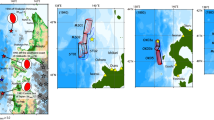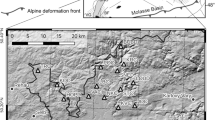Abstract
The parameters of split shear ScS and S waves from the strongest (M w = 8.4) Okhotsk earthquake and its strong aftershocks that occurred in the mantle’s transitional zone in the backarc part of the Kamchatka subduction zone are measured. The measurement results show domination of the fast ScS wave’s east azimuths (110°–149°), which are orthogonal to the trench orientation, and the time difference between the arrivals of the ScS waves (δt) in the range of 0.9–1.6 s. The fast S wave from the Okhotsk earthquake is east-directed (89°), and the time difference between its arrivals is up to 2.5 s. As for aftershocks, the azimuths of the fast S waves are oriented in parallel to the trench, and δt are estimated at 1.2–1.3 s. The orientations of the azimuths for the ScS and S waves are consistent with the model of the transverse-isotropic symmetry of the medium with the symmetry axis tilted along the plate dip and/or along the trench strike.
Similar content being viewed by others
References
L. P. Vinnik, G. L. Kosarev, and L. I. Makeeva, “Anisotropic lithospheres based on SKS and SKKS wave observations,” Dokl. Akad. Nauk SSSR 278(6), 1335–1339 (1984).
Zh Li and D. M. Luneva, “Anisotropic medium and temporal variations of azimuth of rapid S-wave beneath South Kamchatka during 1993–2002,” Fiz. Zemli, No. 4, 40–56 (2006).
L. A. Alpert, T. W. Becker, and I. W. Bailey, “Global slab deformation and centroid moment tensor constraints on viscosity,” Geochem. Geophys. Geosyst 11, Q12006 (2010).
J. R. Bowman and M. Ando, “Shear-wave splitting in the upper-mantle wedge above the Tonga Subduction Zone,” Geophys. J. RAS 88, 25–41 (1987).
P. Chen and M. R. Brudzinski, “Seismic anisotropy in the mantle transition zone beneath Fiji-Tonga,” Geophys. Rev. Lett. 30(13), 1682 (2003).
M. Faccenda, “Mid mantle seismic anisotropy around dubduction zones,” Phys. Earth Planet. Inter. 227, 1–19 (2014).
K. M. Fischer, M. J. Fouch, D. A. Wiens, and M. S. Boettcher, “Anisotropy and flow in Pacific dubduction zone back-arcs,” Pure Appl. Geophys. 151, 463–475 (1998).
B. J. Foley and M. D. Long, “Upper and mid-mantle anisotropy beneath the Tonga slab,” Geophys. Rev. Lett. 38, L02303 (2011).
M. J. Fouch and K. M. Fischer, “Mantle anisotropy beneath Northwest Pacific Plate,” J. Geophys. Res. 101(B7), 15987–16002 (1996).
Y. Fukao, “Evidence from core-reflected shear waves for anisotropy in the Earth’s mantle,” Nature 309, 695–698 (1984).
B. Isacks and P. Molnar, “Distribution of stress in the descending lithosphere from a global survey of focal mechanism solutions of mantle earthquakes,” Rev. Geophys. Sp. Phys. 9, 103–174 (1971).
T. Kawazoe, T. Ohuchi, Y. Nishihara, N. Nishiyama, K. Fujino, and T. Irifune, “Seismic anisotropy in the mantle transition zone induced by shear deformation of wadsleyite,” Phys. Earth Planet. Inter., No. 216, 91–98 (2013).
V. Levin, D. Droznin, J. Park, and E. Gordeev, “Detailed mapping of seismic anisotropy with local shear waves in southeastern Kamchatka,” Geophys. J. Int. 158, 1009–1023 (2004).
M. N. Luneva and J. M. Lee, “Shear wave splitting beneath South Kamchatka during 3-year period associated with the 1997 Kronotsky earthquake,” Tectonophysics 374, 135–161 (2003).
D. Mainprice, A. Tommasi, D. Ferre, P. Carrez, and P. Cordier, “Predicted glide system and crystal preferred orientations of poly-crystalline silicate Mg perovskite at high-pressure: implications for the seismic anisotropy in the lower mantle,” Earth Planet. Sci. Lett. 271, 135–144 (2008).
NEIC, http://earthquake.usgs.gov/regional/neic, United States Geological Survey, USA.
M. Panning and B. Romanowicz, “A three-dimensional radially anisotropic model of shear velocity in the whole mantle,” Geophys. J. Int. 167, 361–79 (2006).
V. Peiton, V. Levin, J. Park, M. T. Brandon, J. Lees, E. Gordeev, and A. Ozerov, “Mantle flow at a slab edge: seismic anisotropy in the Kamchatka Region,” Geophys. Rev. Lett. 28, 379–382 (2001).
W. P. Schellart and L. Moresi, “A new driving mechanism for backarc extension and backarc shortening through slab sinking induced toroidal and poloidal mantle flow: results from dynamic subduction models with an overriding plate,” J. Geophys. Res. Solid Earth, 118 (2013). doi:10.1002/jgrb.50173.
P. Silver and W. Chan, “Shear wave slitting and subcontinental mantle deformation,” J. Geophys. Res. 96(10), 16429–16454 (1991).
A. Tommasi, D. Mainprice, P. Cordier, C. Thoraval, H. Couvy, “Strain-induced seismic anisotropy of wadsleyite polycrystals and flow patterns in the mantle transition zone,” J. Geophys. Res. 109, B12405 (2004).
L. Vecsey, J. Plomerova, and V. Babuska, “Shear-wave splitting measurements—problems and solutions,” Tectonophysics 462, 178–196 (2008).
E. Walsh, R. Arnold, and M. K. Savage, “Silver and chan revisited,” J. Geophys. Res. Solid Earth 118, 1–16 (2013).
E. Wirth and M. D. Long, “Frequency-dependent shear wave splitting beneath the Japan and Izu-Bonin subduction zones,” Phys. Earth Planet. Inter. 181, 141–154 (2010).
J. Wookey and J. M. Kendall, “Evidence of midmantle anisotropy from shear wave splitting and the influence of shear-coupled P waves,” J. Geophys. Res. 109, B07309 (2004).
L. Ye, T. Lay, H. Kanamori, and K. D. Koper, “Energy release of the 2013 Mw 8.3 Sea of Okhotsk Earthquake and deep slab stress heterogeneity,” Science 341, 1380–1384 (2013).
Z. Zhan, H. Kanamori, V. C. Tsai, D. V. Helmberger, and S. Wei, “Rupture complexity of the 1994 Bolivia and 2013 Sea of Okhotsk deep earthquakes,” Earth. Planet. Science. Lett. 385, 89–96 (2014).
Author information
Authors and Affiliations
Corresponding author
Additional information
Original Russian Text © M.N. Luneva, V.V. Pupatenko, 2014, published in Tikhookeanskaya Geologiya, 2014, Vol. 33, No. 6, pp. 63–69.
Rights and permissions
About this article
Cite this article
Luneva, M.N., Pupatenko, V.V. Splitting of ScS and S waves from the M w 8.4 Okhotsk deep-focus earthquake (May 24, 2013) and its strong aftershocks. Russ. J. of Pac. Geol. 8, 456–463 (2014). https://doi.org/10.1134/S1819714014060050
Received:
Published:
Issue Date:
DOI: https://doi.org/10.1134/S1819714014060050




